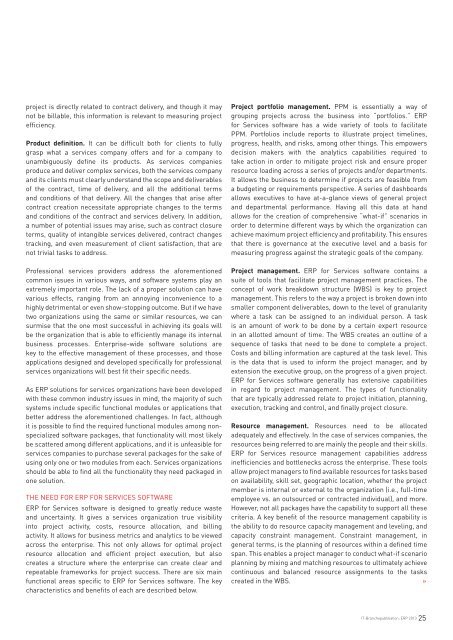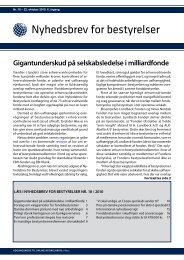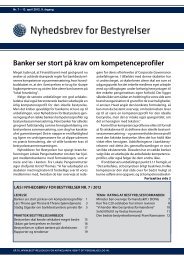IT-Branchepublikation: ERP - Nyhedsbrev for Bestyrelser
IT-Branchepublikation: ERP - Nyhedsbrev for Bestyrelser
IT-Branchepublikation: ERP - Nyhedsbrev for Bestyrelser
Create successful ePaper yourself
Turn your PDF publications into a flip-book with our unique Google optimized e-Paper software.
project is directly related to contract delivery, and though it may<br />
not be billable, this in<strong>for</strong>mation is relevant to measuring project<br />
efficiency.<br />
Product definition. It can be difficult both <strong>for</strong> clients to fully<br />
grasp what a services company offers and <strong>for</strong> a company to<br />
unambiguously define its products. As services companies<br />
produce and deliver complex services, both the services company<br />
and its clients must clearly understand the scope and deliverables<br />
of the contract, time of delivery, and all the additional terms<br />
and conditions of that delivery. All the changes that arise after<br />
contract creation necessitate appropriate changes to the terms<br />
and conditions of the contract and services delivery. In addition,<br />
a number of potential issues may arise, such as contract closure<br />
terms, quality of intangible services delivered, contract changes<br />
tracking, and even measurement of client satisfaction, that are<br />
not trivial tasks to address.<br />
Professional services providers address the a<strong>for</strong>ementioned<br />
common issues in various ways, and software systems play an<br />
extremely important role. The lack of a proper solution can have<br />
various effects, ranging from an annoying inconvenience to a<br />
highly detrimental or even show-stopping outcome. but if we have<br />
two organizations using the same or similar resources, we can<br />
surmise that the one most successful in achieving its goals will<br />
be the organization that is able to efficiently manage its internal<br />
business processes. Enterprise-wide software solutions are<br />
key to the effective management of these processes, and those<br />
applications designed and developed specifically <strong>for</strong> professional<br />
services organizations will best fit their specific needs.<br />
As ErP solutions <strong>for</strong> services organizations have been developed<br />
with these common industry issues in mind, the majority of such<br />
systems include specific functional modules or applications that<br />
better address the a<strong>for</strong>ementioned challenges. In fact, although<br />
it is possible to find the required functional modules among nonspecialized<br />
software packages, that functionality will most likely<br />
be scattered among different applications, and it is unfeasible <strong>for</strong><br />
services companies to purchase several packages <strong>for</strong> the sake of<br />
using only one or two modules from each. Services organizations<br />
should be able to find all the functionality they need packaged in<br />
one solution.<br />
ThE NEED FOr ErP FOr SErVICES SOFTwArE<br />
ErP <strong>for</strong> Services software is designed to greatly reduce waste<br />
and uncertainty. It gives a services organization true visibility<br />
into project activity, costs, resource allocation, and billing<br />
activity. It allows <strong>for</strong> business metrics and analytics to be viewed<br />
across the enterprise. This not only allows <strong>for</strong> optimal project<br />
resource allocation and efficient project execution, but also<br />
creates a structure where the enterprise can create clear and<br />
repeatable frameworks <strong>for</strong> project success. There are six main<br />
functional areas specific to ErP <strong>for</strong> Services software. The key<br />
characteristics and benefits of each are described below.<br />
Project portfolio management. PPM is essentially a way of<br />
grouping projects across the business into “portfolios.” ErP<br />
<strong>for</strong> Services software has a wide variety of tools to facilitate<br />
PPM. Portfolios include reports to illustrate project timelines,<br />
progress, health, and risks, among other things. This empowers<br />
decision makers with the analytics capabilities required to<br />
take action in order to mitigate project risk and ensure proper<br />
resource loading across a series of projects and/or departments.<br />
It allows the business to determine if projects are feasible from<br />
a budgeting or requirements perspective. A series of dashboards<br />
allows executives to have at-a-glance views of general project<br />
and departmental per<strong>for</strong>mance. having all this data at hand<br />
allows <strong>for</strong> the creation of comprehensive “what-if” scenarios in<br />
order to determine different ways by which the organization can<br />
achieve maximum project efficiency and profitability. This ensures<br />
that there is governance at the executive level and a basis <strong>for</strong><br />
measuring progress against the strategic goals of the company.<br />
Project management. ErP <strong>for</strong> Services software contains a<br />
suite of tools that facilitate project management practices. The<br />
concept of work breakdown structure (wbS) is key to project<br />
management. This refers to the way a project is broken down into<br />
smaller component deliverables, down to the level of granularity<br />
where a task can be assigned to an individual person. A task<br />
is an amount of work to be done by a certain expert resource<br />
in an allotted amount of time. The wbS creates an outline of a<br />
sequence of tasks that need to be done to complete a project.<br />
Costs and billing in<strong>for</strong>mation are captured at the task level. This<br />
is the data that is used to in<strong>for</strong>m the project manager, and by<br />
extension the executive group, on the progress of a given project.<br />
ErP <strong>for</strong> Services software generally has extensive capabilities<br />
in regard to project management. The types of functionality<br />
that are typically addressed relate to project initiation, planning,<br />
execution, tracking and control, and finally project closure.<br />
Resource management. resources need to be allocated<br />
adequately and effectively. In the case of services companies, the<br />
resources being referred to are mainly the people and their skills.<br />
ErP <strong>for</strong> Services resource management capabilities address<br />
inefficiencies and bottlenecks across the enterprise. These tools<br />
allow project managers to find available resources <strong>for</strong> tasks based<br />
on availability, skill set, geographic location, whether the project<br />
member is internal or external to the organization (i.e., full-time<br />
employee vs. an outsourced or contracted individual), and more.<br />
however, not all packages have the capability to support all these<br />
criteria. A key benefit of the resource management capability is<br />
the ability to do resource capacity management and leveling, and<br />
capacity constraint management. Constraint management, in<br />
general terms, is the planning of resources within a defined time<br />
span. This enables a project manager to conduct what-if scenario<br />
planning by mixing and matching resources to ultimately achieve<br />
continuous and balanced resource assignments to the tasks<br />
created in the wbS. »<br />
<strong>IT</strong>-<strong>Branchepublikation</strong>: <strong>ERP</strong> 2013<br />
25






